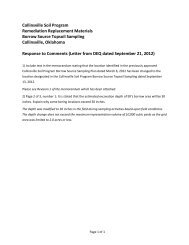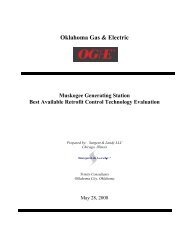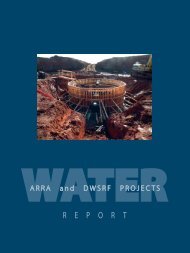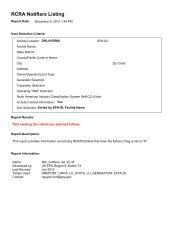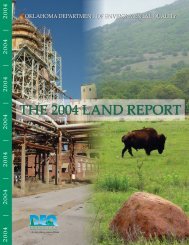Technical documentation and software quality assurance for project ...
Technical documentation and software quality assurance for project ...
Technical documentation and software quality assurance for project ...
You also want an ePaper? Increase the reach of your titles
YUMPU automatically turns print PDFs into web optimized ePapers that Google loves.
€<br />
A second parameter <strong>for</strong> the Baker-Strehlow-Tang (BST) approach is the reactivity<br />
of the released gas. Reactivity ratings used by Zeeuwen <strong>and</strong> Wiekema (1978) classify<br />
reactivity based upon chemical laminar burning velocity. Low reactivity has velocities<br />
less than 45 cm/sec. High reactivity applies to those chemicals with burn velocities<br />
greater than 75 cm/sec <strong>and</strong> anything in between is labeled medium reactivity. Most of the<br />
flammable chemicals in ALOHA do not have reactivity values. As a default (reactivity<br />
not known), the model uses medium reactivity.<br />
Based upon values <strong>for</strong> congestion <strong>and</strong> reactivity, BST estimates turbulent flame<br />
speed in Mach number. The model uses recent Mach values (Pierorazio et al, 2005) that<br />
are higher than those found in earlier publications. These newer values are based upon<br />
larger scale experiments <strong>and</strong> are claimed to better represent results typical of an industrial<br />
plant incident. Note, in certain cases, the tables predict that there will be a deflagration to<br />
detonation transition (DDT). Based upon a recommendation from the external review<br />
team, the model uses the same Mach number as in the hard ignition detonation scenario.<br />
reactivity\congestion<br />
low medium high<br />
high 0.36 DDT DDT<br />
medium 0.11 0.44 0.5<br />
low 0.026 0.23 0.34<br />
Table 2 : Revised Baker-Strehlow-Tang flame speeds (Mach number)<br />
The Baker-Strehlow-Tang-model uses a set of empirically determined graphs of<br />
normalized overpressure versus normalized distance with a different graph <strong>for</strong> different<br />
flame speeds. The model does a curve fit to these graphs, using a function of the <strong>for</strong>m<br />
y = D if x < x 0<br />
else y = A ⋅ B 1/ x x C<br />
where A, B, C, D, <strong>and</strong> x0 are constants. The table gives values of these constants <strong>for</strong><br />
various flame Mach numbers<br />
constants\Mach €<br />
0.2 0.35 0.7 5.2<br />
A 0.0335 0.1041 0.3764 0.2932<br />
B 0.8359 0.8642 0.7439 1.399<br />
C -1.1192 -1.0568 -1.2728 -1.1591<br />
D 0.065 0.22 0.65 20<br />
x0 0.35 0.32 0.3 0.16<br />
Table 3 : Curve fit constants <strong>for</strong> various Mach numbers <strong>for</strong> use in the BST method<br />
The normalized distance, x, is defined as<br />
€<br />
20



